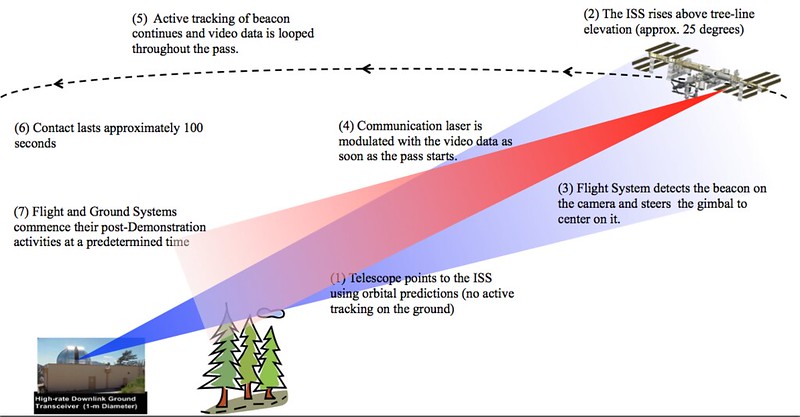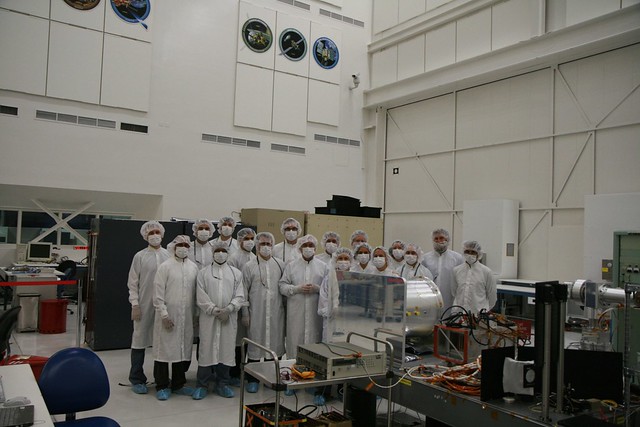The day after Curiosity landed on Mars, that first blurry Hazcam picture appeared everywhere on the Internet with one of two types of comments. Some were in the vein of "I can't hear you over the sound of my Sky Crane landing a nuclear-powered, laser-wielding car on Mars." Others were the "I spend $2 billion and all I got was this crappy picture" type. People seemed almost outraged that, in this day and age, we didn't have high resolution images coming back from the rover during landing. The fact is, Curiosity isn't equipped for high enough rates of data transfer to beam back massive image files from Mars. But that might not be the case on future rovers, thanks to NASA’s new OPALS program.OPALS, short for Optical Payload for Lasercomm Science, is an upcoming mission from NASA's Jet Propulsion Laboratory that will demonstrate optical communications technologies from a platform on the ISS to a ground station at the center's Optical Communications Telescope Laboratory in Wrightwood, California.Laser communications represent a major break from traditional methods of spacecraft communications that are done using radio waves. Radio waves are on the longer end of the electromagnetic communication spectrum. For example, S-band radio is made of longer waves, 10 centimeters or about 4 inches, that can't transmit a lot of data in one go. On the plus side, they're really easy to receive – radio waves spread out in all directions from their point of origin and can pass easily through things like clouds. The benefits have long outweighed the downside of limited data transfer, and radio communications have been a staple from the shuttle program to Sirius XM radio.Laser communications use much shorter wavelengths in the high end of the visible light spectrum, and these shorter wavelengths can transmit a lot more data. In the case of the OPALS mission, the payload will operate with wavelengths around 1,500 nanometers.Of course, there's a catch. Laser communications work sort of like laser pointers. The data travels in a concentrated beam of light. And just like how a laser pointer makes a dot on a wall no matter how far away you are, laser communications come from space in that same narrow band. To receive laser communications, the signal has to be aimed very precisely at a receiver on Earth. OPALS is hoping to prove that this tricky maneuver is hard, but not impossible. Once the flight hardware is loaded on the ISS via one of SpaceX's Falcon 9 rockets, the team will track its orbit carefully. As soon as the station passes in view of the receiver (i.e. the telescope in Wrightwood), the orbiting OPALS flight system will detect a beacon on the ground then use its gimbals to lock "eyes" with the telescope. Then it will fire the laser, which will transfer a preselected loop of video material, for the 100 second pass. Once the ISS passes out of range, the team will debrief and reset for the next one.If everything works out, the OPALS team's finds may go beyond the one mission and lend support for another NASA laser communications program, the Laser Communications Relay Demonstration, that's headed by the Goddard Spaceflight Center. LCRD is a long duration mission that will push the state of the art of laser communications further.
Once the flight hardware is loaded on the ISS via one of SpaceX's Falcon 9 rockets, the team will track its orbit carefully. As soon as the station passes in view of the receiver (i.e. the telescope in Wrightwood), the orbiting OPALS flight system will detect a beacon on the ground then use its gimbals to lock "eyes" with the telescope. Then it will fire the laser, which will transfer a preselected loop of video material, for the 100 second pass. Once the ISS passes out of range, the team will debrief and reset for the next one.If everything works out, the OPALS team's finds may go beyond the one mission and lend support for another NASA laser communications program, the Laser Communications Relay Demonstration, that's headed by the Goddard Spaceflight Center. LCRD is a long duration mission that will push the state of the art of laser communications further. But that's not the only benefit. The OPALS mission is part of JPL's Phaeton early career employee hands-on training program. The team behind OPALS is young. The core team based at JPL are mostly under 30.JPL created the Phaeton program at the urging of its younger engineers who wanted real experience in major positions on missions; new grads, of course, don't walk into NASA and become Flight Director on a flagship mission like the Mars Science Laboratory. Phaeton gives these new grads the chance to run their own lower cost but higher risk missions, giving them the training they'll need to take the reigns on flagship missions of the future.
But that's not the only benefit. The OPALS mission is part of JPL's Phaeton early career employee hands-on training program. The team behind OPALS is young. The core team based at JPL are mostly under 30.JPL created the Phaeton program at the urging of its younger engineers who wanted real experience in major positions on missions; new grads, of course, don't walk into NASA and become Flight Director on a flagship mission like the Mars Science Laboratory. Phaeton gives these new grads the chance to run their own lower cost but higher risk missions, giving them the training they'll need to take the reigns on flagship missions of the future.
Advertisement
Advertisement

Diagram of the OPALS system (click to enlarge)
